
W HAT L IES B ENEATH : C ALIFORNIA
A TWODOT BOOK
An imprint and registered trademark of Globe Pequot, the trade division of The Rowman & Littlefield Publishing Group, Inc.
4501 Forbes Blvd., Ste. 200
Lanham, MD 20706
www.rowman.com
Distributed by NATIONAL BOOK NETWORK
Copyright 2021 by Gail L. Jenner
All photos by Gail L. Jenner unless otherwise noted
Map by Melissa Baker
All rights reserved . No part of this book may be reproduced in any form or by any electronic or mechanical means, including information storage and retrieval systems, without written permission from the publisher, except by a reviewer who may quote passages in a review.
British Library Cataloguing in Publication Information available
Library of Congress Cataloging-in-Publication Data available
ISBN 978-1-4930-4895-3 (paper : alk. paper)
ISBN 978-1-4930-4896-0 (electronic)
 The paper used in this publication meets the minimum requirements of American National Standard for Information SciencesPermanence of Paper for Printed Library Materials, ANSI/NISO Z39.48-1992.
The paper used in this publication meets the minimum requirements of American National Standard for Information SciencesPermanence of Paper for Printed Library Materials, ANSI/NISO Z39.48-1992.
To my two sisters, Patricia Mae Peterson and Teresa M. Davis.
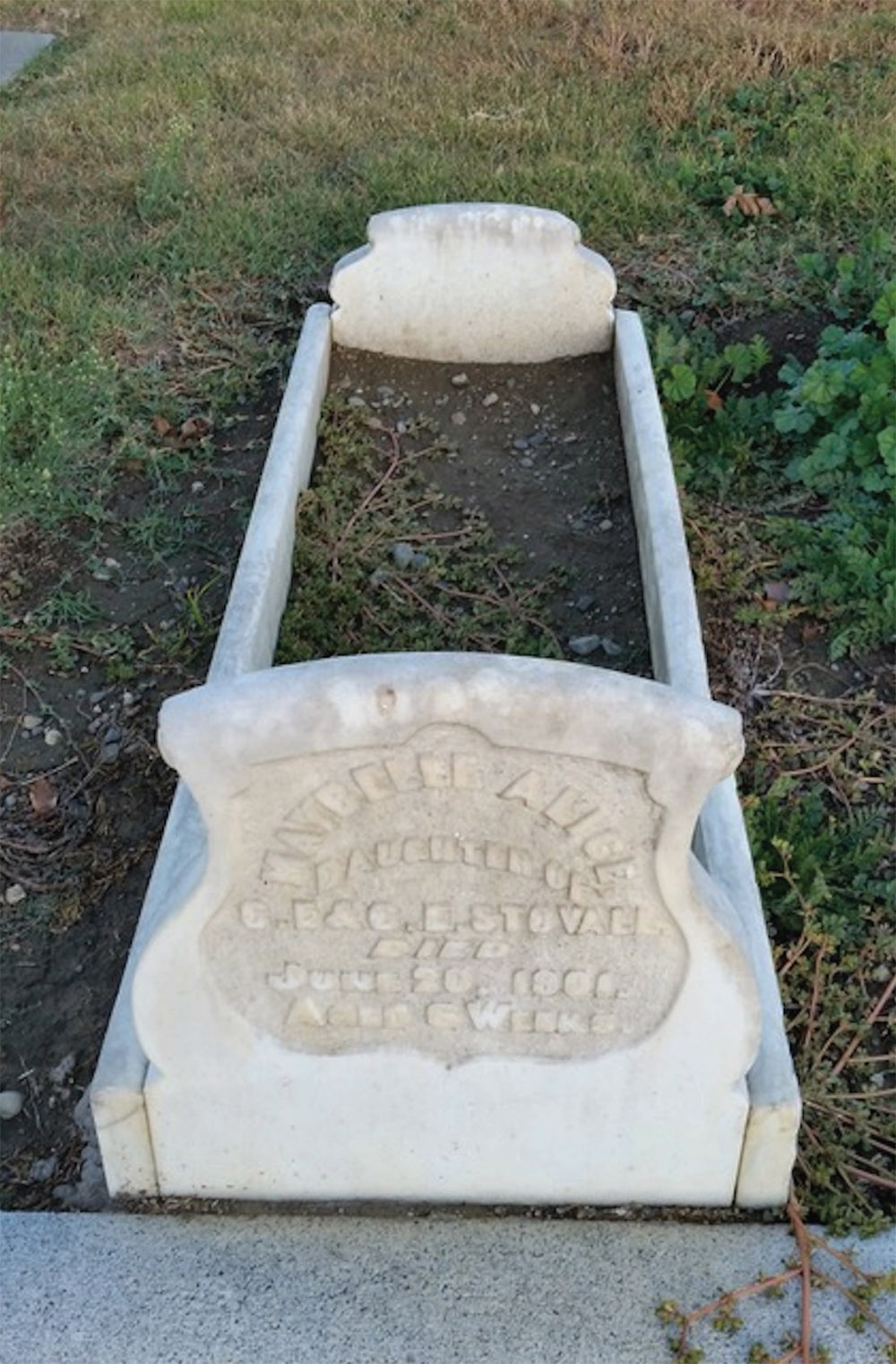
Grave of Maybelle Alice, daughter of C. E. and C. E. Stovall, June 20, 1901, Williams Cemetery, Colusa County, feels eerie.
INTRODUCTION
E veryone loves a mystery and as you enter through the battered gates of old, overgrown cemeteries or graveyards, there is a decided air of mystery that hovers over them. Perhaps that is why we are drawn to themmuch like looking over into the dark abyss where you cannot see what is beyond sightand why our imaginations are ignited.
The importance of such places cannot be underestimated, particularly in terms of history. Not only do the variety of headstones or crypts or monuments pique curiosity about the lives once lived, there is something more. Is it the tangible but fragile link we have to death itself? Whether we believe or dont believe in what follows this life, the desire to find a connection to the possibility of an afterlife draws us to these places of eternal rest.
As an avid lover of genealogy and anything historical, cemeteries have always interested me. Who were these people and what did they suffer? What did they overcome? Those lives cut off at birth or ten or forty-eight or ninety-fourwhether by illness, age, or accidentcause me to stand and ponder the circumstances surrounding their living and dying. To see a family plot where one, two, or three children or infants have been laid to rest is tragic. You see the small headstones, topped with a lamb or angel, with the simple but devastating words: At rest or Sleep, Our Baby. To lose one child would be heartbreaking, but to witness the heartbreak of multiple losses feels grotesquely unfair and terrible.
Take, for instance, Mark Schofield (18351890) of New York. After marrying Eliza Ann Schofield (18401877), the couple traveled cross-country to California and settled in Sierra County, where Mark took a job as a superintendent for a mining company. They were off to a wonderful beginning and then their first child, a daughterAmelia Adalinewas born on Christmas Day, 1868. However, in May 1871, Amelia passed away and they laid her to rest in the Whiskey Diggings Cemetery , in Sierra County. A second child, Alice, was born in January 1872, and she died in June of 1873; she was only seventeen months old. A third daughter, Ida, was born in May 1876.
What more could happen? Eliza Ann passed away a year later, on May 2, 1877. She was 37 years old and one month later, in June 1877, little Ida passed away. Mark Schofield had lost three daughters and his wife in the spread of nine years. All four of them were interred in Whiskey Diggings Cemetery.
As if this were not grievous enough, on November 23, 1890thirteen years laterMark Schofield, superintendent of the North America Mine, near Gibsonville, Sierra County, entered the mine with several other employees to retimber a portion of it. Suddenly the men began scrambling about as they tried to back out of the mine. It only took a few minutes before they realized they were being overwhelmed by a toxic gas, known as white damp. Six men collapsed on the car track before they could escape and others rushed in to rescue as many as they could, but Schofield, who had been the first in, could not be resuscitated. It was too late. Even the horse that had been pulling the mining cart died from the gas. Mark Schofield was laid to rest beside his wife and three daughters in the Whiskey Diggings Cemetery in Sierra County in November 1890. At fifty-five years, his life and legacy had been brought to an end.
And then there is the Hiram Page Cemetery in Yreka, Siskiyou County. Hiram and his sons are interred in a private, off-the-road, singular graveyard, with one large marble headstone that sits outside a white picket fence. The plot measures about eight by eight inches, and its a spot that people suddenly see as theyre driving by. It is not a destination, but sits at an anglealmost resting against a treealongside a residential road not far from a senior living project. Apparently, in 1863, the site was close to the Page family farm. Were they headed home, or headed to town?
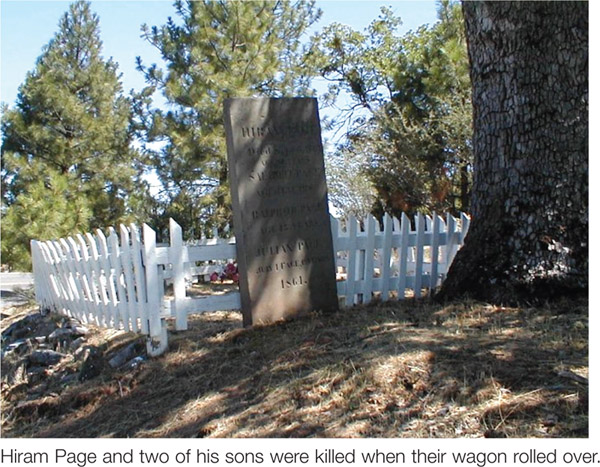
Hiram Page (18221863), Hiram Balpher Page (18491863), and Salathiel Page (18511863) were all killed when their wagon turned over. Rather than trying to haul them away, rescuers buried them near their home. One more name was added to the tombstone one year later, that of six-year-old Julian Page (18571864). No doubt, it would have been a relief for the boys mother, Ellie Dodge Page, and sister Minnie Page (18571944) to have them buried close at hand. If families find proximity to their dead a comfort, though it may be small comfort to some, the poem One Final Gift by D. J. Kramer reflects an apt emotion for Ellie and Minnie. Here are the final lines:
Dont leave my resting place unmarked
As though you never cared.
Deny me not one final gift
For all who come to see...
A single lasting proof that says
I loved... and you loved me.
A third story from 1878 rests in the Angle Cemetery in Willits, Mendocino County. Located on a small knoll in the middle of a pasture and nestled under a copse of trees are the graves of Rench Angle (18281889) and nine of his fifteen childrensix of whom died between May 30 and June 13 from diphtheria. Originally from Pennsylvania, Rench Angle was the first owner of the now-famous Ridgewood Ranch of Seabiscuit fame. He was, at one time, one of the wealthiest men in Mendocino County. After his death, his widow, Mahulda Catherine Orender Angle (18401925), married Sylvester Drew, and after he died, she married John H. Christy. When she passed at eighty-three, she was buried in an unmarked grave in the Ukiah Cemetery , in Ukiah, Mendocino County, beside her father, Joel Orender (18131891). The question lingers: How does one handle that much grief?
The stories of these and others from Californias earliest days need to be remembered and not just by those whose lives were connected in time and space. No, for me, the desire to recapture and preserve a dying history is what propelled this project. My research and journey to over 100 cemeteries up and down California was not conducted to share the names or deeds of well-known individuals who already fill history books or local lore, but to uncover lesser-known or even unknown individuals, whose lives and challenges, deeds and foibles should not be lost to time.
Next page

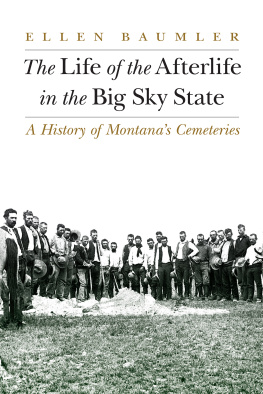

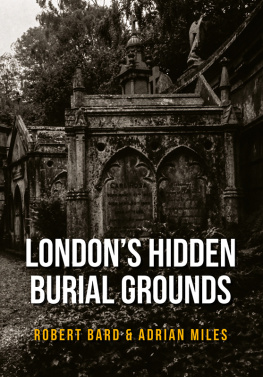
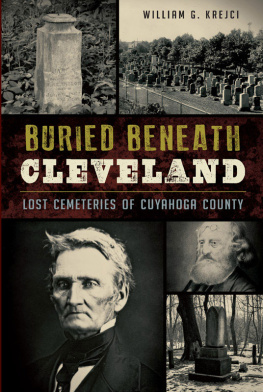
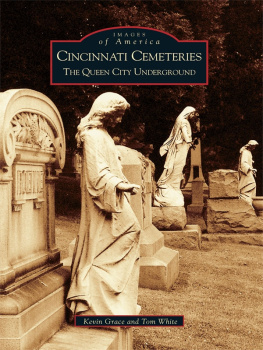
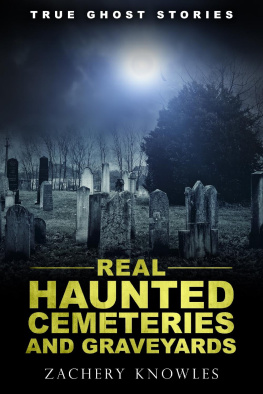
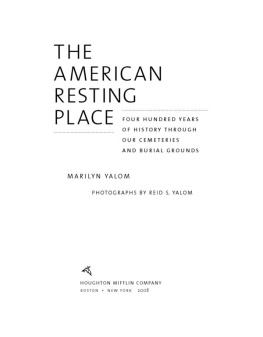
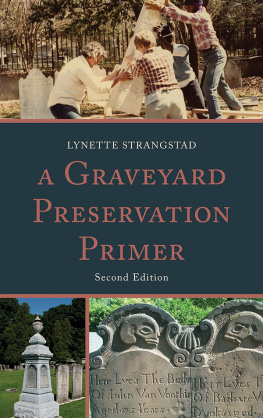

 The paper used in this publication meets the minimum requirements of American National Standard for Information SciencesPermanence of Paper for Printed Library Materials, ANSI/NISO Z39.48-1992.
The paper used in this publication meets the minimum requirements of American National Standard for Information SciencesPermanence of Paper for Printed Library Materials, ANSI/NISO Z39.48-1992.
